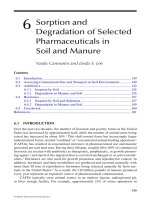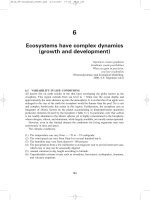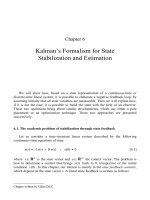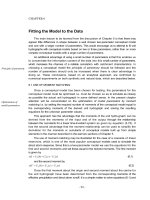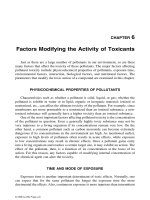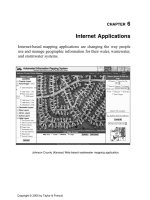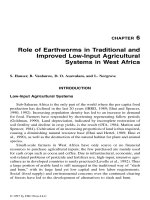Chapter 6 dynamical systems handout
Bạn đang xem bản rút gọn của tài liệu. Xem và tải ngay bản đầy đủ của tài liệu tại đây (953.52 KB, 40 trang )
Dynamical Systems
Nguyen An Khuong,
Huynh Tuong Nguyen
Chapter 6
Dynamical Systems
Discrete Mathematics II/Mathematical Modelling
Contents
Introduction
Malthusian Growth
Model
Properties of the
systems
System of ODEs
Homeworks
Nguyen An Khuong, Huynh Tuong Nguyen
Faculty of Computer Science and Engineering
University of Technology, VNU-HCM
6.1
Contents
Dynamical Systems
Nguyen An Khuong,
Huynh Tuong Nguyen
1 Introduction
Contents
2 Malthusian Growth Model
Introduction
Malthusian Growth
Model
3 Properties of the systems
Properties of the
systems
System of ODEs
Homeworks
4 System of ODEs
5 Homeworks
6.2
Dynamical Systems
Change?!
Nguyen An Khuong,
Huynh Tuong Nguyen
• Dynamical systems: Tools for constructing and manipulating
models
• So we often have to model dynamic systems.
• Discrete −→ difference equations (“linear" vs “nonlinear",
“single variable" vs “multivariate")
• Continuous −→ differential equations (“ordinary" vs “partial";
“linear" vs “nonlinear")
• We will formulate the equations, analyze their properties and
learn how to solve them.
• To start there are many good references on this subject,
including:
Contents
Introduction
Malthusian Growth
Model
Properties of the
systems
System of ODEs
Homeworks
• F.R. Giordano, W.P. Fox & S.B. Horton, A First Course in
Mathematical Modeling, 5th ed., Cengage, 2014.
• A Iserles, A First Course in the Numerical Analysis of
Differential Equations, 2nd. Cambridge University Press, 2008
6.3
Single Species Equations: Growth
Dynamical Systems
Nguyen An Khuong,
Huynh Tuong Nguyen
• Basic concept that individuals divide to increase a population
can be modeled mathematically using a differential equation
• Can loosely be applied to populations that don’t divide to
populate
• Attributed to Malthus, who in 1798 found small group of
organisms obeyed growth law
Contents
Introduction
Malthusian Growth
Model
Properties of the
systems
System of ODEs
Homeworks
• The solution to the equation concerned him greatly
6.4
Dynamical Systems
Exponential Growth
Nguyen An Khuong,
Huynh Tuong Nguyen
• As an example, consider the classic example of bacteria on a
petri dish.
• Let’s say the number on the plate grows by 10% each hour
and the initial population is x0 = 1000.
Contents
• After the first hour: x1 = 1000 + (0.1) ∗ 1000 = 1000 ∗ (1.1)
Introduction
Malthusian Growth
Model
• After the second hour:
x2 = 1000 ∗ (1.1) + (0.1) ∗ (1000 ∗ 1.1) =
1000 ∗ (1.1) ∗ (1.1) = 1000 ∗ (1.1)2
Properties of the
systems
System of ODEs
• After the third hour: x3 = 1000 ∗ (1.1)3 etc.
t
Homeworks
t
• In general, xt = xo (1 + r) which can be written as xt = x0 a
where a = (1 + r) The solution for the Bacteria is thus an
exponential function of base 1 + r.
• The (discrete) dynamical system: xt = axt−1 . (recurrent
relation/difference equation)
6.5
Dynamical Systems
Instantaneous Exponential Growth
Nguyen An Khuong,
Huynh Tuong Nguyen
• In the last slide we examined growth at some kind of finite
increment using an average growth rate r over that increment.
• What happens if the growth process is continuous?
• Divide the growth process over the time increment into nt
stages with the growth rate for each stage being
the average growth over the increment.
r
n
where r is
Contents
Introduction
r nt
) .
(1)
n
• Look at the limit as we divide our interval into ∞ pieces.
x(t) = xo (1 +
Malthusian Growth
Model
Properties of the
systems
System of ODEs
Homeworks
r
lim x0 [(1 + )n/r ]rt .
n→∞
n
• We can pull x0 out of the limit. In brackets we have the
irrational number e:
x(t) = x0 ert .
(2)
(3)
6.6
Dynamical Systems
Instantaneous Exponential Growth (cont’d)
Nguyen An Khuong,
Huynh Tuong Nguyen
• Our time-dependent population equation satisfies the
fundamental differential equation:
dx
= x0 = rx
(4)
dt
where r is the (in this situation) constant growth rate.
(See how to derive the equation above in page 462, [Giordano
et al.], eqn(11.5).)
• The solution to these equation can be found by separating
variables and integrating.
x˙ =
Contents
Introduction
Malthusian Growth
Model
Properties of the
systems
System of ODEs
ln|x(t)| = rt + c
(5)
Homeworks
and applying the initial condition that x(0) = xo at t = 0 to
get
ln |x(t)| = rt + ln |xo |
(6)
• Take the exponential of both sides to give the exact solution
to the instantaneous growth equation
x(t) = xo ert
(7)
6.7
Dynamical Systems
Exponential Growth: Solution properties
Nguyen An Khuong,
Huynh Tuong Nguyen
• We can calculate the time to double the population (known
as the "rule of 70" in financial circles)
.70
ln(2)
∼
.
r
r
• What does the solution look like? On a log plot, it is a
straight line of slope r.
tdouble =
(8)
Contents
Introduction
Malthusian Growth
Model
Properties of the
systems
System of ODEs
Homeworks
• Is this realistic?
6.8
Dynamical Systems
What if our growth rate was negative?: Mortality
Nguyen An Khuong,
Huynh Tuong Nguyen
x˙ = −mx
(9)
• We have exponential decay. Solution will tend toward zero, no
matter what the initial condition was
Contents
Introduction
Malthusian Growth
Model
Properties of the
systems
System of ODEs
Homeworks
• Most systems have both growth and decay terms.
• Example, our phytoplankton equation will have terms for
growth as a function of light, temperature, and nutrients, and
decay (mortality).
6.9
Dynamical Systems
More realistic model: Finite Resources
Nguyen An Khuong,
Huynh Tuong Nguyen
• We now know that growth cannot continue forever because of
finite resources and in fact in simplified scenarios will reach a
given constant level K know as the carrying capacity of the
system.
• Verhulst noticed that simple populations appear to be capped
x˙ = rx(1 − x)
Introduction
Malthusian Growth
Model
and added an additional term to remove excess capacity.
x
x˙ = rx(1 − )
K
• We can always nondimensionalize this by the carrying
capacity to give
Contents
Properties of the
systems
(10)
System of ODEs
Homeworks
(11)
• This is commonly known as logistic growth
6.10
Dynamical Systems
Logistic Growth: Solution
Nguyen An Khuong,
Huynh Tuong Nguyen
• This equation has solutions that tend toward K for all initial
conditions except for x = xo for which there is no growth
(assuming there is no such thing as a negative population).
• So, this is mathematically equivalent to a density dependent
0
growth rate r = r(1 − x).
Contents
Introduction
Malthusian Growth
Model
Properties of the
systems
• Solution to this equation is
System of ODEs
Homeworks
xo K
x(t) =
xo + (K − xo )e−rt
(12)
6.11
Dynamical Systems
Arbitrary Growth: Polynomial
Nguyen An Khuong,
Huynh Tuong Nguyen
• These equations are of the general form
(13)
x˙ = g(x)
2
where g(x) is a polynomial: g(x) = ao + a1 x + a2 x ....
• Malthus, all coefficients are zero except for a1 = r. Growth
•
•
•
•
rate constant
Verhults (logistic), growth rate decreases monotonically
a0 = 0 by argument that a population can’t spontaneously
exist
One can fit any population, but will not elucidate any
dynamics
Allee effect: Growth rate might be maximal somewhere in
between x = 0 and the carrying capacity. Low numbers, can’t
find mates, high numbers, competition/resources.
g(x) = a0 + a1 x + a2 x2
Contents
Introduction
Malthusian Growth
Model
Properties of the
systems
System of ODEs
Homeworks
(14)
• If a1 > 0 and a2 < 0 we have the Allee effect
6.12
Dynamical Systems
Critical Points (Fixed Points)
Nguyen An Khuong,
Huynh Tuong Nguyen
• Fixed points are steady state solutions of ordinary differential
equations.
• For example, consider the general form of our single species
Contents
population equation x˙ = f (x):
Introduction
x˙ = 0 ⇒ f (x) = 0
(15)
• In ecosystem dynamics, these fixed points are also known as
critical points. For the Malthus system (exponential growth),
we have:
x˙ = αx = 0 ⇒ x
ˆ=0
Malthusian Growth
Model
Properties of the
systems
System of ODEs
Homeworks
(16)
• There is only one critical point (x = 0). How could we reach
this solution?
6.13
Dynamical Systems
Stability of Critical Points
Nguyen An Khuong,
Huynh Tuong Nguyen
What is the nature of the solution near the critical point? Consider,
two possibilities for a frog pond starting from a steady state:
1
2
Five frogs are killed in a freak accident. The frog population
returns to the steady state. stable
Contents
Introduction
The frog population crashes: unstable
Malthusian Growth
Model
• Let’s look at the stability of our exponential growth x˙ = αx
critical point x = 0.
Properties of the
systems
System of ODEs
• If we perturb x to x = 5, what will happen?
x(t) = xo eαt = 5eαt
Homeworks
(17)
• System will grow exponentially away from the critical point:
critical point is unstable
6.14
Stability of Critical Points: cont’d
Dynamical Systems
Nguyen An Khuong,
Huynh Tuong Nguyen
Contents
Introduction
Malthusian Growth
Model
Properties of the
systems
System of ODEs
Homeworks
• B: Unstable
• A: Stable
This example relates to states of potential energy, but the analogy
holds for energy in an ecosystem.
6.15
Dynamical Systems
Stability of Critical Points: Logistic Equation
Nguyen An Khuong,
Huynh Tuong Nguyen
Logistic equation:
x
)
K
Solve for fixed points with x˙ = f (x) = 0. Two fixed points:
x˙ = αx(1 −
(18)
Contents
Introduction
1
xˆ1 = 0 Nothing exists
2
xˆ2 = K Population is at carrying capacity
Though experiment: Are these stable:
1
x = 0: Perturb system from nothing, what will happen:
growth! (Unstable)
2
x = K: Perturb system from carrying capacity, what will
happen return to K (Stable)
Malthusian Growth
Model
Properties of the
systems
System of ODEs
Homeworks
We will analyze this more rigorously
6.16
Stability of Linear Systems
Dynamical Systems
Nguyen An Khuong,
Huynh Tuong Nguyen
For linear ODEs of the form: x˙ = αx, the stability can be
determined simply from the sign of α:
• α > 0: Unstable (growth)
• α < 0: Stable (decay)
This is obvious from the solution: x(t) = xo eαt .What about
nonlinear ODEs:
x
x˙ = αx(1 − )?
(19)
K
Trick is to linearize about the critical point. What is linearization:
We approximate a nonlinear function with a linear function that is
quite accurate at a given point.
Contents
Introduction
Malthusian Growth
Model
Properties of the
systems
System of ODEs
Homeworks
6.17
Dynamical Systems
Linearization
Nguyen An Khuong,
Huynh Tuong Nguyen
• We linearize a function near a given point using a Taylor
Series.
• For example, take a nonlinear function g(x).
• With approximation theory, we can show that the following
series f (x) converges to the exact function g(x) at x = a
Contents
Introduction
0
f (x) = g(a) + g (a)(x − a) + H.O.T.
(20)
• If we retain only the first two terms (zeroth order and linear)
we have the linearization L(x) of the function g(x) about the
point a.
•
0
L(x) = g(a) + g (a)(x − a) ∼ g(x)
Malthusian Growth
Model
Properties of the
systems
System of ODEs
Homeworks
(21)
• What do we need to compute this linearization?
1 The first derivative of the function g(x) evaluated at the
point x = a
2 The value of the function at a (g(a))
6.18
Dynamical Systems
Linearization example: Sin
Nguyen An Khuong,
Huynh Tuong Nguyen
• The sin function is a complex, irrational function.
• However, if we are working around small angles, we can often
replace it with a more compact function using the
linearization.
• For example, the governing equation for a pendulum is:
Contents
Introduction
ă + mgl sin = 0
I
(22)
Malthusian Growth
Model
Properties of the
systems
where Θ is the angle of perturbation from the vertical.
• We can simplify the solution if we linearize sin about Θ = 0:
System of ODEs
Homeworks
L(sin Θ) = 0 + cos(Θ)|T heta=0 (Θ − 0) = Θ
(23)
• Using the so-called small angle approximation: we can
simplify the D.E. to be:
ă + mglΘ = 0
IΘ
(24)
6.19
Dynamical Systems
Stability of the Logistic Equation
Nguyen An Khuong,
Huynh Tuong Nguyen
• Let’s analyze the stability of the critical points of the Logistic
Equation.
• First, let’s evaluate the first derivative:
Contents
Introduction
2αx
f (x) = α −
K
• At the point x = 0, we have, for the Linearization:
0
(25)
Malthusian Growth
Model
Properties of the
systems
System of ODEs
Homeworks
L(x) = 0 + α(x − 0) = αx
(26)
• So, near the critical point x = 0, our logistic equation
behaves as L(x) = αx (why is this not surprising).
• Thus it is an unstable critical point.
6.20

